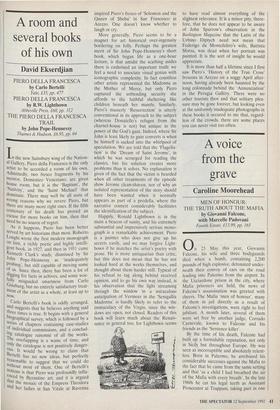A room and several books of his own
David Ekserdjian
PIERO DELLA FRANCESCA by Carlo Bertelli Yale, £35, pp. 477 PIERO DELLA FRANCESCA by R.W. Lightbown Abbeville Press, £60, pp. 312 THE PIERO DELLA FRANCESCA TRAIL by John Pope-Hennessy Thames & Hudson, £6.95, pp. 64 In the new Sainsbury wing of the Nation- al Gallery, Piero delta Francesca is the only artist to be accorded a room of his own. Admittedly, two fresco fragments by his mentor, Domenico Veneziano, are given house room, but it is the 'Baptism', the 'Nativity', and the 'Saint Michael' that dominate. There may well be all sorts of wrong reasons why we revere Piero, but there are many more right ones. If the fifth centenary of his death has proved an excuse for more books on him, then that need be no source of regret. As it happens, Piero has been better served by art historians than most. Roberto Longhi wrote the first modern monograph on him, a richly poetic and highly intelli- gent book, in 1927, and then in 1951 came . Kenneth Clark's study, dismissed by Sir John Pope-Hennessy as 'inadequately Probing', but still capable of moving some of us. Since then, there has been a lot of digging for facts in achives, and some woe- fully misguided smartness from Carlo unzburg, but no entirely satisfactory treat- ment of the artist as a whole, at least up to
now.
Carlo Bertelli's book is oddly arranged, and suggests that he believes anything said three times is true. It begins with a general biographical survey, which is followed by a series of chapters containing case-studies Of individual commissions, and a conclud- ing catalogue raisonne of all the works. The overlapping is a waste of time, and only the catalogue is not positively danger- °Iis. It would be wrong to claim that Bertelli has no new ideas, but perfectly reasonable to suggest that we could do Without most of them. One of Bertelli's notions is that Piero was profoundly influ- enced by Byzantine art, and it is argued that the mosaic of the Empress Theodora and her ladies in San Vitale at Ravenna
inspired Piero's fresco of 'Solomon and the Queen of Sheba' in San Francesco at Arezzo. One doesn't know whether to laugh or cry.
More generally, Piero seems to be a magnet for art historical over-ingenuity bordering on folly. Perhaps the greatest merit of Sir John Pope-Hennessy's short book, which began life as a one-hour lecture, is that amidst the scathing asides there is enshrined an important truth: we feel a need to associate visual genius with iconographic complexity. In fact countless other artists represented the Madonna as the Mother of Mercy, but only Piero captured the unbending security she affords to the faithful sheltering like children beneath her mantle. Similarly, Piero's masterly 'Resurrection' is utterly conventional in its approach to the subject (whereas Donatello's refugee from the charnel-house is not) but unique in the power of the God's gaze. Indeed, where Sir John is least likely to gain converts is when he himself is sucked into the whirlpool of speculation. We are told that the 'Flagella- tion' is the 'Dream of Saint Jerome', in which he was scourged for reading the classics, but his solution creates more problems than it solves. No explanation is given of the fact that the victim is bearded when all other treatments of the episode show Jerome clean-shaven, nor of why an isolated representation of the story should have been wanted when it normally appears as part of a predella, where the narrative context considerably facilitates the identification of the subject.
Happily, Ronald Lightbown is in the main a beacon of sanity, and his extremely substantial and impressively serious mono- graph is a remarkable achievement. Piero is a painter who does not give up his secrets easily, and we may forgive Light- bown if he matches the artist's poetry with prose. He is more antiquarian than critic, but this does not mean that he has not looked hard at the works themselves, and thought about them harder still. Typical of his refusal to tag along behind received opinion, and to go his own way instead, is his observation that the light streaming through the window in a miraculous anticipation of Vermeer in the `Senigallia Madonna' is hardly likely to refer to the immaculacy of the Virgin, since the win- dows are open, not closed. Readers of this book will learn much about the Renais- sance in general too, for Lightbown seems
to have read almost everything of the slightest relevance. It iS a minor pity, there- fore, that he does not appear to be aware of John Sparrow's observation in the Burlington Magazine that the Latin of the Urbino Diptych need not mean that Federigo da Montefeltro's wife, Battista Sforza, was dead when her portrait was painted. It is the sort of insight he would appreciate.
It is more than half a lifetime since I first saw Piero's 'History of the True Cross' frescoes in Arezzo on a soggy April after- noon, having already been haunted by the long colonnade behind the 'Annunciation' in the Perugia Gallery. There were no other tourists then and that solitary plea- sure may be gone forever, but looking even at the uniformly inadequate photographs in these books it occured to me that, regard- less of the crowds, there are some places you can never visit too often.


































































 Previous page
Previous page